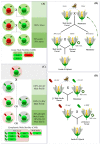Protoplast Technology and Somatic Hybridisation in the Family Apiaceae
- PMID: 36903923
- PMCID: PMC10005591
- DOI: 10.3390/plants12051060
Protoplast Technology and Somatic Hybridisation in the Family Apiaceae
Abstract
Species of the family Apiaceae occupy a major market share but are hitherto dependent on open pollinated cultivars. This results in a lack of production uniformity and reduced quality that has fostered hybrid seed production. The difficulty in flower emasculation led breeders to use biotechnology approaches including somatic hybridization. We discuss the use of protoplast technology for the development of somatic hybrids, cybrids and in-vitro breeding of commercial traits such as CMS (cytoplasmic male sterility), GMS (genetic male sterility) and EGMS (environment-sensitive genic male sterility). The molecular mechanism(s) underlying CMS and its candidate genes are also discussed. Cybridization strategies based on enucleation (Gamma rays, X-rays and UV rays) and metabolically arresting protoplasts with chemicals such as iodoacetamide or iodoacetate are reviewed. Differential fluorescence staining of fused protoplast as routinely used can be replaced by new tagging approaches using non-toxic proteins. Here, we focused on the initial plant materials and tissue sources for protoplast isolation, the various digestion enzyme mixtures tested, and on the understanding of cell wall re-generation, all of which intervene in somatic hybrids regeneration. Although there are no alternatives to somatic hybridization, various approaches also discussed are emerging, viz., robotic platforms, artificial intelligence, in recent breeding programs for trait identification and selection.
Keywords: biotechnological breeding; carrot; celery; cybrids; male sterility; protoplast isolation and fusion.
Conflict of interest statement
The authors declare no conflict of interest.
Figures



References
-
- Chadipiralla K., Gayathri P., Rajani V., Reddy P.V.B. Plant tissue culture and crop improvement. In: Roychowdhury R., Choudhury S., Hasanuzzaman M., Srivastava S., editors. Sustainable Agriculture in the Era of Climate Change. Springer; Cham, Switzerland: 2020. pp. 391–412.
-
- Suenaga L. Basic studies on transfer of cytoplasmic male sterility by means of cytoplasmic hybridization in carrot: (Daucus carota L.) J. Fac. Agric. Hokkaido Univ. 1991;65:62–118.
-
- Yu X., Lu H., Lu G., Chen Z., Cao J., Hirata Y. Analysis of genetic diversity in cytoplasmic male sterility, and association of mitochondrial genes with petaloid-type cytoplasmic male sterility in tuber mustard (Brassica juncea var. tumida Tsen et Lee) Mol. Biol. Rep. 2009;37:1059–1067. doi: 10.1007/s11033-009-9830-x. - DOI - PubMed
Publication types
LinkOut - more resources
Full Text Sources

